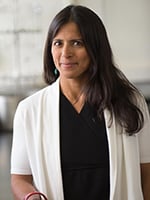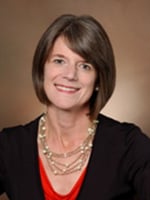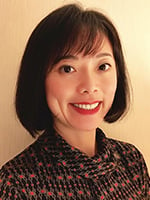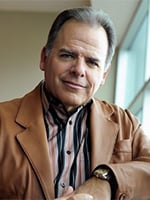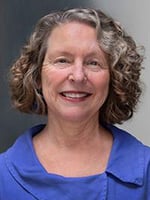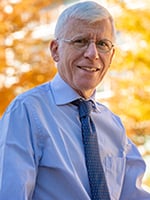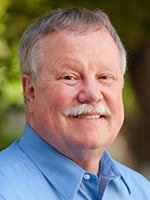Professors and faculty members at most research universities spend the bulk of their professional time in well-known academic pursuits: teaching, researching, collaborating with colleagues, and leading the next generation of experts in their respective fields. Less apparent are hundreds of hours some volunteer to present at conferences, provide testimony for policies, and collaborate on scientific committee work, publish papers, and review others’ work for publication.
One distinguished but often less publicized volunteer effort is chairing or sitting on a variety of committees within the National Academies of Sciences, Engineering and Medicine (NASEM). At the Colorado School of Public Health (ColoradoSPH), many faculty volunteer with NASEM committees, and in this role, they help to shape policies that address many of the most pressing national issues and problems.
Elizabeth P. Ryan
NASEM is a force for scientific inquiry with roots that run deeply in the country’s soil, noted ColoradoSPH Dean Dr. Jonathan Samet. In 1863, in the midst of the Civil War, President Abraham Lincoln signed into law a bill that created the National Academy of Sciences. The 49 original members of the Academy served without pay – a standard that remains – and pledged only to offer politics-free guidance based on evidence.
“Lincoln recognized the importance of science to inform the government on key matters,” said Samet, a member of the National Academy of Medicine since 1997. The National Academy of Engineering and the National Academy of Medicine (originally the Institute of Medicine) were founded in 1964 and 1970, respectively.
Samet noted that experts from a wide variety of disciplines – his are pulmonology and epidemiology – drive NASEM’s work. They gather to consider, debate, analyze and synthesize the evidence that will be used by leaders to make decisions that affect the daily lives of millions of Americans. For example, he currently chairs a standing committee that assists the Department of State on how best to protect department employees and their families who live overseas in cities with air pollution levels significantly higher than those in the United States. And recently, Samet became chair of a committee that is addressing respiratory protection for the population at large and workers not currently covered by regulations.
He called the advisory work and the resulting evidence syntheses from committees a “critical translational step” in the decision-making process for lawmakers. “It’s one way we turn science into policy.”
Jill Norris
Broad influence
The issues addressed by ColoradoSPH faculty in their past and present NASEM committee work cover plenty of ground with roots in the real world. They range from assessing airborne transmission of the SARS-CoV-2 virus to reviewing research into autoimmune diseases to identifying best practices for emergency preparedness to helping devise an efficient process for establishing standards that safeguard our health. Some of the work looks forward to emerging challenges, such as delivering care to the growing number of cancer survivors and those with Alzheimer’s disease and Alzheimer’s-related dementias.
Along the way, committee members grapple with thorny questions, such as how to improve access to quality health care and deliver care more equitably. And these are only representative examples of the work ColoradoSPH faculty have contributed to NASEM.
The committees produce hundreds of publications available to decision- and policy-makers, researchers, and the general public. The concrete results are vital, said Colorado State University’s Dr. John Volckens, a self-described “public health engineer” who served with Samet on a committee studying airborne transmission of the SARS-CoV-2 virus. The committee organized a virtual workshop that presented evidence that small virus particles could travel more than six feet and made a case for more restrictive indoor measures, such as masks and improved exchange of indoor air with outdoor air.
Tianjing Li
“Scientific information that is not translated to actionable information doesn’t meet its full potential,” Volckens said. “Any opportunity I can get to translate science into decision-making, I’m all for.”
His sentiment was shared by Dr. Elizabeth Ryan, a toxicologist also with ColoradoSPH at CSU, who serves on NASEM’s standing Committee on Toxicology. The members oversee research into environmental and occupational exposures that pose diverse, life-spanning health challenges, and serve multiple agencies in need of guidance, such as the Department of Defense.
The work addresses “any topic under the sun,” that relates to helping department leaders understand the risks and safe levels of exposure to chemicals, Ryan said.
“We provide expertise beyond academics,” Ryan said. “It’s about giving recommendations to the DoD and others so they can use evidence-based guidelines to move forward. You see important work that one hopes will have application in the future, as opposed to just conducting an academic exercise.”
The Board on Global Health offers a good example of the extensive and detailed publications produced by NASEM. ColoradoSPH epidemiology and CU School of Medicine faculty member Dr. Tianjing Li contributed to “Crossing the Global Quality Chasm: Improving Health Care Worldwide,” a forward-looking report released in 2018 while Li was with the Johns Hopkins University Bloomberg School of Public Health. The report contrasts the current fragmented healthcare system with a vision for a more equitable future and recommendations for a path forward.
Spero Manson
“The report is a framework for science for the next five to 10 years, and points the direction for future research,” Li said. The publicly available publication is a resource for policymakers, healthcare payers, researchers, and anyone interested in health care change, she added.
Forward-thinking
Indeed, several ColoradoSPH faculty serve on committees that consider how to address looming challenges of the coming decade and beyond. For example, Dr. Spero Manson, distinguished professor and director of the Centers for American Indian and Alaska Native Health at ColoradoSPH, is a medical anthropologist who has been a member of the National Academy of Medicine since 2002, and is currently a member of a 16-member committee that surveys behavioral and social sciences research on Alzheimer’s disease and Alzheimer’s-related dementia. The aim: develop new areas for investigation over the next decade. An advisory panel that includes individuals living with dementia and others who provide care for a family member with the disease provides additional input.
Dr. Cathy Bradley, ColoradoSPH’s Associate Dean for Research, and a professor and deputy director of the University of Colorado Cancer Center, is a specialist in cancer control and prevention who serves on the NASEM National Cancer Policy Forum. The group regularly convenes workshops to address “topics that are critical to consider in cancer care,” she said.
Lisa Bero
For example, a three-part workshop in January dealt with considering the evidence for making treatment decisions in older adults with cancer – a growing group. Another session deals with the effects of the Affordable Care Act on the 17 million cancer survivors in the United States.
The Forum workshops contemplate one basic question about cancer care from a wide angle, Bradley said. “What does the world that we want to be in look like?”
The NASEM Roundtable on the Promotion of Health Equity stages workshops that consider another stubborn societal problem: disparities in healthcare delivery and outcomes between different racial and ethnic groups. A workshop in late April 2020 considered the inequities laid bare by the COVID-19 pandemic, said Dr. Ned Calonge, a member of the National Academy of Medicine, president of The Colorado Trust and ColoradoSPH faculty member who was part of the roundtable.
The workshop helped to highlight the disproportionate infection, hospitalization, and death rates for African Americans and Latinos during the COVID-19 pandemic, Calonge added.
“The numbers don’t have to do with the virus itself,” he said. “It has to do with the social structure we have in our country and ongoing inequities in opportunity, employment, and health care.”
Evidence-based assessments and recommendations
The committees also help to define future policy priorities in important areas. Dr. Jill Norris, chair of ColoradoSPH’s Department of Epidemiology, has her first NASEM assignment on a committee that assesses the National Institutes of Health’s research into autoimmune diseases – a huge collection of conditions that affect up to 24 million people in the United States. Among many other tasks, the committee aims to identify promising areas of research for diseases that the evidence shows demand the greatest attention.
Cathy Bradley
For example, if data reveal that the prevalence of an autoimmune disease like rheumatoid arthritis is increasing, the committee can review what types of research the NIH is funding to look into the issue and assess if it is adequate, Norris said.
“If not, what are the barriers?” she added. “Are there things we can do to increase research and what are the areas we need to focus on?”
Drs. Bradley and Li serve on a current committee that similarly aims to spur further research and bolster evidence-based care. The committee is looking at recommendations by the U.S. Preventive Services Task Force (USPSTF), the federal panel that makes recommendations about important protective clinical services, such as screenings for colorectal and cervical cancers for specific groups of people.
The USPSTF assigns these services grades – A through D – based on the certainty of their benefit to patients. Colorectal and cervical cancer screenings, for example, received “A” grades. The committee is looking critically at those that receive an “I” for having insufficient evidence to assign a grade. Rather than leave it at that, the committee wants to find a way to categorize the insufficiencies. Are more clinical trials needed? Is more study required based on age, race, sex, or some other criteria?
“By looking at insufficient evidence, funders can then issue calls to generate that evidence,” Bradley said.
The committee work also includes requests, sometimes from Congress, to review the methods that regulatory agencies use to reach balanced policy judgments. Dr. Lisa Bero, a pharmacologist and senior editor for Cochrane Public Health and Health Systems, is internationally known for her studies on the integrity of evidence review, and chairs a committee reviewing an Environmental Protection Agency handbook used to develop assessments of the risks to people and the environment from exposure to contaminants.
Jonathan Samet
The basic question: Is the EPA using state-of-the-art methods to identify, evaluate and synthesize the evidence used to form those assessments? It’s a complicated issue, said Bero, a faculty member in the CU School of Medicine and ColoradoSPH. The handbook describes the methods used to identify hazardous chemicals and at what levels they pose a risk. A thorough chemical assessment should look at “all relevant data” to assess the risk of bias in how the data were selected and measured, as well as conflicts of interest. The assessments produced by EPA are used by states and globally as the evidence base for regulating chemicals.
“We want to use the most rigorous methods to assess these chemicals and protect the public,” Bero said, “and ensure that the EPA can take all of the data into account to set an exposure level that protects workers and the public.”
Many benefits
The committee work requires a significant time commitment. But all agreed the benefits are substantial. Manson, for example, said the committees feature a diversity of backgrounds and expertise that contributes to producing quality work.
“I don’t believe truth lies anywhere singularly,” Manson said. “Out of a multitude of views emerges a very rich understanding of issues and priorities for addressing gaps in knowledge that can make a difference in the lives of people suffering from a condition under consideration.”
Volckens said the great challenges of our time – such as responding to a global pandemic and the rising threat of climate change – can’t be met by a single discipline. Reducing the threat of COVID-19, for example, requires not only clinical, research, and engineering solutions but also behavioral changes by the public. That amplifies the importance of NASEM and its multidisciplinary committee work.
Ned Calonge
“We have to get better at speaking to each other as scientists,” Volckens said. “We have to be able to weave our discussions together to help make decisions.”
Many faculty members said they also appreciate the opportunity to network with other professionals, even if the meetings have for nearly a year been conducted remotely because of the pandemic.
“It’s a learning opportunity and a chance to expand my knowledge,” Li said. “The people you work with on committees are not the same folks you see at professional meetings.”
“The committee work has broad impact, and it is an honor and a privilege to work with smart people,” Bradley added. “It is always a joy to be part of it and to be asked to have input and be able to make a difference in areas I am passionate about.”
Samet said work with NASEM yields new opportunities with every committee assignment. “I’ve learned much about how to bring science to the issues that people face in their lives,” he concluded.
Guest contributor: Tyler Smith. Photo at top: Vlad Tchompalov on Unsplash

